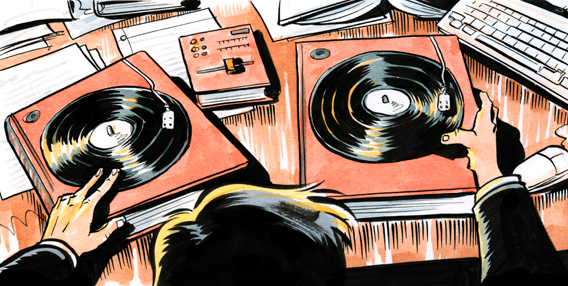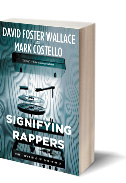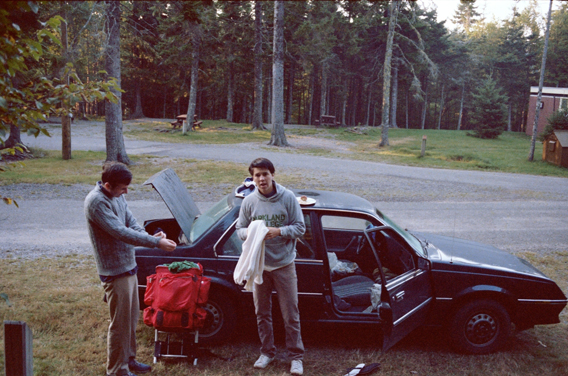
Slate is an Amazon affiliate and may receive a commission from purchases you make through our links.
My Metonym for Self-Reference Weighs a Ton
When the “resoundingly and in all ways white” David Foster Wallace tried to write about hip-hop.

Illustration by Nate Powell
Since 2008, the year that David Foster Wallace committed suicide, there has been a steady stream of posthumous publications, none of which, as a matter of strict biblio-taxonomy, would have any business occupying the same section of your local ink-and-paper bookseller. We’ve had This Is Water (inspirational commencement speech), The Pale King (unfinished novel), Fate, Time, and Language: An Essay on Free Will (undergraduate philosophy thesis), and Both Flesh and Not (essays and criticism). Let’s say, for the sake of argument, that you still bought physical books from that local bookseller: You’d have to do some considerable legwork around the place just to get your hands on all these posthumous Wallace books. There aren’t many figures in the landscape of contemporary literature who as fully embody Susan Sontag’s memorable definition of a writer as “someone interested in everything.” Wallace really was interested in everything: madly, distractedly, encyclopedically interested. (He wrote a book on that topic, too: Everything and More: A Compact History of Infinity, for which, I suppose, you might want to look in “popular science.”)
And now that Signifying Rappers—the short book about hip-hop he co-authored with his friend Mark Costello in 1990—is back on the shelves in a new edition, you’d also have to make a music section stop-off in that hypothetical bookstore expedition. Wallace made it his business to be the kind of writer for whom no one section of the bookstore could be a natural home. And so a book like this, as minor an entry as it is in the DFW oeuvre, is representative of his work precisely because of how incongruous it seems. He wrote brilliantly about what he knew, of course—tennis, addiction, television, the self-devouring solipsism of a particular kind of heterosexual maleness—but some of his best essay writing and journalism resulted from putting himself in situations in which he was absurdly, perspiringly out of place (porno award ceremonies, luxury cruises, lobster festivals, so forth).
Signifying Rappers is characterized by a similar dislocation of author and subject, but it never achieves the exquisite style or penetrating insight of those later intellectual excursions. Much of this has to do with the fact that the 26-year-old Wallace, in his sections of the book, is plainly not yet the writer he would go on to become in his 30s and 40s. The self-conscious didacticism and performative equivocation are there, as is the uneasy synthesis of sincerity and irony, but the prose seems too often just compulsively wordy, the voice too awkwardly enamored of its own academic-vernacular register. It also feels odd, from the vantage point of 2013, to be reading a critical argument for rap’s worthiness of serious critical consideration.
And the book is more frustrating than that, as it’s mostly concerned with the difficulties of approaching this “closed, prepositionally black, Other” music. “The fenestrated barriers to any real upscale white appreciation of rap and its Scene looked almost Romanesque-esque,” Wallace writes, “until we hit on the The-Barriers-Are-Part-of-Any-White-Appreciation strategy.” That fussily demotic tone is in itself a little off-putting here, but the sentence is representative of a larger problem with the book: It is interested less in the subject of rap per se than the distance between its authors and that subject. Throughout, Wallace and Costello are just far too engrossed in the apparent incongruity of their own enjoyment—as “two highbrow upscale whites”—of a genre which is “very self-consciously, music by urban blacks about same to and for same.”
Twenty-four years on, rap is still a largely African-American art form, but the presence of white participants in and commentators on rap culture is no longer remarkable. (It was probably never as remarkable as the authors seem to think it was.) And so one of the strangest, most alternately intriguing and frustrating aspects of this book, is the obsessive—which is to say very DFW-ish—way in which it keeps anxiously gesturing toward its own compromised authority to speak about its subject at all. “Please know,” Wallace entreats us early on, “we’re very sensitive to this question: what business have two white yuppies trying to do a sampler on rap?” The first of its three main sections is entitled “Entitlement,” which, obviously, is punningly self-reflexive in a number of ways at once. Before anything’s even been said at all, the whole thing is already contriving to deconstruct itself.

For a writer so deeply serious about the difficulties and responsibilities of community and citizenship, Wallace had comparatively little to say, elsewhere in his work, about the complexities of race in America. It just wasn’t, generally, an area on which his ethical intelligence shone with any particular brilliance. One of the few really unsuccessful stretches of Infinite Jest comes early on, and is sometimes a deal-breaker for readers who have yet to be convinced that they should keep turning its untold pages. It’s a short detour about the sexual abuse and horrific violence suffered by a girl named Wardine, and it’s narrated in a stilted vernacular that reads like a grim parody of ebonics. (“Wardine be cry. Reginald he down and beg for Wardine tell Reginald momma how Wardine momma treat Wardine.”) It’s hard to believe a writer as sensitive and self-examining as Wallace didn’t know exactly what he was doing here, but it’s equally hard for the reader to figure out what exactly that was. (It’s worth noting that this was one of the first parts of the novel he wrote; it originated in a short story written for a graduate writing program in 1986.)
In his fantastic 1999 essay “Authority and American Usage”—which itself contains a diversion about a speech Wallace gave as a teacher to black students on the importance of learning to write in Standard Written (or “Standard White”) English—Wallace describes himself as “resoundingly and in all ways white.” It’s this resounding whiteness that is the dominant note in Signifying Rappers. There’s an odd conflict at the heart of the whole project: Wallace and Costello set out, as two white guys, to offer an explanation and defense of rap music to their readers, while also focusing relentlessly on the fact that, as two white guys, they can never really get close to that subject in the first place. There’s a scrupulous, sometimes comic self-consciousness to the Us and Them divide that runs through the book, but this doesn’t mitigate its failure to transcend that divide. (This problem is sometimes aggravated by a tendency to view rap as speaking for urban black communities as a whole—as “synecdochic,” in Wallace’s term.)
Wallace and Costello were writing at the tail end of the ’80s, at a time when hip-hop’s position in pop culture was just starting to become truly major—when Public Enemy, Gang Starr, Eric B. and Rakim, N.W.A., and De La Soul were all asserting their presences in the mainstream. Because the two white guys are implicitly addressing an audience that needs convincing of rap’s seriousness as art, there’s quite a lot of explaining being done here, very little of which now makes for edifying or interesting reading. “The rapper,” writes Wallace, “offers lyrics that are spoken or bellowed in straight stressed rhymed verse, the verse’s syntax and meter often tortured for rhythmic gain or the kind of limboing-for-rhyme we tend to associate with doggerel about men from Nantucket.” The DJ, we are told, “is responsible for the song behind and around the rap––the backbeat, krush groove, and the ‘sound carpet,’ i.e. a kind of electric aural environment.” It’s interesting, from the vantage point of 2013, to see exactly who and what Wallace and Costello take seriously, and in what ways. The Beastie Boys are dismissed, several times over, as “execrable,” “godawful,” and essentially talentless—an assessment which, on the basis of their pre-1989 output, is understandable if harsh. Public Enemy, as you’d expect, are given much more consideration. Wallace has a riff, for instance, on the line “I show you my gun/ My Uzi weighs a ton,” and, specifically, the fact that Chuck D’s talking here about the weight and firepower of his lyrics, as opposed to any literal weapon. Wallace points out that this is an inversion of the usual way in which, historically, pop lyrics substituted innocuous terms for controversial signifieds (where something like “Baby, here is my love” would be an obvious euphemism for “Baby, here is my dick”). Chuck’s Uzi, he argues, serves in the lyrics as “nothing more than a metonym for self-reference” whereby “the song itself becomes the true deep referent in the meaning-layered lyrics of any music that wishes to enjoy the favors of outrage-hungry pop audience and conservative entertainment industry alike.”

Photo by N.C. Larson
Like much of the critical treatment given to rap lyrics in the book, it’s clever, but not much more than that. As an introduction to late ’80s rap, the whole thing is pretty idiosyncratic all round. Eric B. and Rakim, for instance, are barely given the time of day, while the authors are convinced of—and largely convincing on—Schoolly D’s greatness as a kind of postmodern troubadour. His trash-talk epic “Signifying Rapper” is, Wallace writes, “a new type of cut that opens up Hard rap’s artistic possibilities even further, effecting an historical closure by which this high-tech genre insiders define as ‘any rhythmic rhymes spoken over a strong beat’ can perform its best-rooted and probably strongest function: storytelling.”
Of course, as the cover makes clear, Wallace is not the only author of this book. In fact, the layout keeps reminding us that we’re dealing with two distinct authorial presences: Wallace’s sections are headed “D.” and Costello’s “M.” This back and forth is possibly more in the spirit of Chuck and Flavor than, say, Deleuze and Guattari; Wallace’s sections tend to close with explicit segues into Costello’s, often with actual colons, or partial sentences (one section ends with the words “As in,” a small example of Wallace’s tendency to aestheticize incompletion). Costello’s presence is secondary, although by no means incidental. A lot of the material he covers in his sections draws on his background as a lawyer—there’s a fair amount of discussion of the civil rights movement, on the growing problem of gang violence in Boston, and some mildly interesting stuff on the legal issues around sampling and copyright infringement. There’s also a long disquisition on Jesse Jackson’s claim that he was at MLK’s side when he died, which is interesting on its own terms, but never quite gets around to being relevant.
The heavy critical lifting, though, is mostly Wallace’s work. Costello’s involvement seems to have grown out of the fact that he happened to be living with Wallace at the time he was writing it. Because of their shared enthusiasm for rap, Wallace asked Costello to read what he was writing, and their conversations on the essay evolved into a kind of informal two-dude symposium. “On occasions when we did not overlap in the apartment or take a drive together,” says Costello in the preface, “I sometimes wrote my reply to parts of his rap essay. A yeah-but or a what-if, left on his desk. It was Dave’s idea to incorporate my responses and turn the essay into a co-authored book with intercut voices.”
The idea for the book, Costello says, came out of a panel Wallace was part of. “A fellow panelist launched a rote attack on rap as violent, anti-white, anti-women, bling-obsessed. Dave defended the artists he knew, praising the dexterity, the wordplay, the raucous, raw assault on the sententious Babbittry of the Age of Reagan.” An editor who attended the panel suggested that Wallace write an essay in defense of the form—an essay, says Costello, “that might have carried the title ‘How Rap, Which You Hate, Is Not What You Think, And Is Interesting as Hell, and, If Offensive, a Useful Sort of Offensive Given What Is Happening Today.’ ” That projected title, for all its familiarly performative loquaciousness, actually gives a pretty succinct idea of what Wallace is up to in the project that eventually became Signifying Rappers. The “You” being addressed is an implied readership of white intellectuals with a sketchy and dismissive view of rap. (A fact which accounts for, but makes no less retrospectively awkward, the spectacle of two white intellectuals lengthily defining terms like “ill” and “def.”) The book, in this sense, is a sort of critical diplomatic mission on behalf of a hip-hop culture Wallace is explicitly doubtful he has any real business speaking about, let alone for. Although it’s sometimes interesting on the experience of being a white fan of a predominantly black art form, there’s a relentless fetishization of rap’s “Otherness,” its difference, its closure against outsiders; and this, eventually, comes to seem like a way of concealing a scarcity of real insight into the music itself.
But while we’re on the topic of critical self-consciousness, it’s probably a bit obtuse to insist on reading this book as though its arguments about the cultural consequence of late ’80s hip-hop, and its analysis of the complexities of the white fan experience, were the main grounds on which it should be considered. It is in one sense, as Costello puts it in his preface, “a deeply dorked-out artifact of 1989.” But it’s also an artifact in the ongoing exhibition of Wallace’s intellectual omnivorousness. The book is a failure, but one that can only really be seen within the overall context of a dramatically successful career. “A major impediment to sampling this Scene,” writes Wallace at one point, “is the kaleidoscopic fury with which the Scene itself’s changing. I.e., if you’re reading this in print it’s already dated.” This is true now in ways Wallace probably couldn’t have predicted when he wrote it. The cultural landscape of the book’s original significance has receded, and given way to an entirely different context—the magnitude of its co-author’s subsequent achievement. Which is another way of saying that it is, essentially, that most DFW-ish of things: a footnote.
---
Signifying Rappers by David Foster Wallace and Mark Costello. Back Bay Books.
See all the pieces in this month’s Slate Book Review.
Sign up for the Slate Book Review monthly newsletter.
